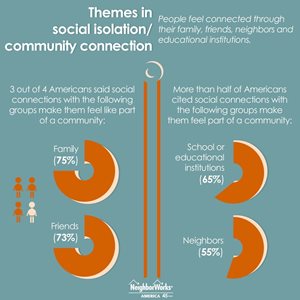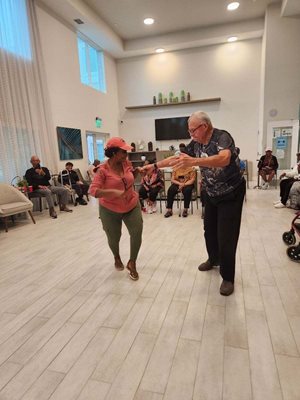In Texas, a NeighborWorks network organization holds community activities year-round to bring residents together. In Florida, a teatime and social hour connect residents in a 55 and older community. In different locations and in different ways, NeighborWorks network organizations are addressing social isolation in an effort to ensure healthy, thriving communities. A consumer survey from NeighborWorks America shows just how essential that is.
NeighborWorks' survey on Social Isolation and Community Connections underlines the need to fight isolation – especially in communities of color. The survey also seeks to understand Americans' experiences with social isolation.
 Findings show that while 73% of respondents see friends and even more see family as essential to making them feel they're part of a community, housing itself can make a big impact on feelings of connectedness.
Findings show that while 73% of respondents see friends and even more see family as essential to making them feel they're part of a community, housing itself can make a big impact on feelings of connectedness.
Forty three percent of adults, for instance, say they are most likely to develop social connections with people in their community through housing by getting to know people in close proximity to where they live or stay. Around 27% point to involvement in community and neighborhood events or groups like gardening clubs, homeowners associations and prevention councils, and 24% mention involvement in recreational activities like sports leagues/games or trivia. Forty one percent say they find connection related to educational activities in which they or their children participate.
Across the network, NeighborWorks network organizations have found ways to promote connectivity. They have designed living spaces to facilitate social interaction in community rooms or outdoors. They've incorporated social programing into their services. They've focused on transportation to make sure that people in their housing aren't physically isolated.
Alamo Community Group (ACG), a NeighborWorks network organization in San Antonio, is currently restructuring some of their resident services activities. But connectivity is always on their minds. "Our buildings have resident services coordinators, and probably more than 50% of their jobs are in community-building," says Christine Drennon, acting executive director.
Drennon says low-income individuals often find a safety-net in personal friendships and families. It is those connections that provide help and childcare when they need it, for example. "That is how they gain a sense of security and well-being. At higher-level incomes, people can buy security and well-being. But at lower incomes, it is the relationships. We try to encourage those relationships at our 11 properties, so people feel safe and fulfill their needs. We want to be proactive."
ACG also tries to foster relationship-building in their public spaces. In the past, they've provided spaces for youth to gather after school, and held potlucks and family friendly events. "It often involves food," Drennon explains. "That's how you can break down barriers, especially if there's a potluck and people are sharing."
The organization recently applied for a grant to help fund more activities for older residents, where they most worry about isolation. The hope is to provide more transportation along with coffee hours, BINGO and more. Still, "the people who show up for public events are not the most vulnerable," Drennon says. "It's the people who stay home." The organization's goal, she adds, is to draw them out.
NeighborWorks' survey shows that people crave safe spaces to gather and connect with each other, says Romi Hall, NeighborWorks' director of Healthy Homes & Communities. "The NeighborWorks network offers resident services, arts and cultural activities and health care to boost people's resilience and address urgent needs."
Organizations also offer health and wellness programing, creating another space for residents to engage with one another and build relationships.
At Orlando Neighborhood Improvement Corporation (ONIC), a NeighborWorks network organization in Florida, communities have always meant more than "roofs and walls," says LaSonashia McFadden, resident services manager. That's why they established a robust Resident Services Program: To coordinate enhanced and asset-building services designed to increase residents' quality of life. The program supports residents with activities, services and programs, determined by input, interest and need. And while they are open to the broader community, activities are place-based, reaching residents, literally, where they live. 
Staff at Preserve at Emerald Villas, a 55+ community, work especially hard to nurture connections among residents, she says. That has included a food pantry, which brought in 600 resident visits last year, community conversations and a tea party and social hour.
Over half of the NeighborWorks network supports community planning, community celebrations and other community building initiatives that facilitate strong community relationships and build connections across sectors, Hall says. Their role remains important, especially as one quarter of Americans, according to the survey, say they've had a very difficult or somewhat difficult time resuming social activities since the pandemic restrictions have been lifted. That has been especially true for people of color.
Research shows that isolation has a detrimental effect on health. According to the U.S. Centers for Disease Control, loneliness and isolation have shown an increased risk in everything from heart disease to Type 2 Diabetes.
NeighborWorks America has long worked at the intersection between health and housing — and has forged partnerships aimed at bolstering community health and well-being. Next month, NeighborWorks will lead a conversation that addresses "Co-creating an Equitable Future at the Intersection of Health, Housing and Community Development."
The daylong symposium will explore the future of resident-led strategies across health, housing and community development. Using emergent learning, the symposium will engage community leaders and experts in the field to identify new opportunities, while listening to the stories of residents who know best how to improve the places they call home.
Look for more NeighborWorks surveys on our website.
01/16/2024

